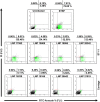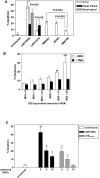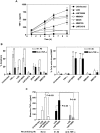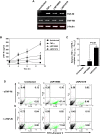Differential modulation of TNF-alpha-induced apoptosis by Neisseria meningitidis
- PMID: 19412525
- PMCID: PMC2669886
- DOI: 10.1371/journal.ppat.1000405
Differential modulation of TNF-alpha-induced apoptosis by Neisseria meningitidis
Abstract
Infections by Neisseria meningitidis show duality between frequent asymptomatic carriage and occasional life-threatening disease. Bacterial and host factors involved in this balance are not fully understood. Cytopathic effects and cell damage may prelude to pathogenesis of isolates belonging to hyper-invasive lineages. We aimed to analyze cell-bacteria interactions using both pathogenic and carriage meningococcal isolates. Several pathogenic isolates of the ST-11 clonal complex and carriage isolates were used to infect human epithelial cells. Cytopathic effect was determined and apoptosis was scored using several methods (FITC-Annexin V staining followed by FACS analysis, caspase assays and DNA fragmentation). Only pathogenic isolates were able to induce apoptosis in human epithelial cells, mainly by lipooligosaccharide (endotoxin). Bioactive TNF-alpha is only detected when cells were infected by pathogenic isolates. At the opposite, carriage isolates seem to provoke shedding of the TNF-alpha receptor I (TNF-RI) from the surface that protect cells from apoptosis by chelating TNF-alpha. Ability to induce apoptosis and inflammation may represent major traits in the pathogenesis of N. meningitidis. However, our data strongly suggest that carriage isolates of meningococci reduce inflammatory response and apoptosis induction, resulting in the protection of their ecological niche at the human nasopharynx.
Conflict of interest statement
The authors have declared that no competing interests exist.
Figures







References
-
- Klein NJ, Ison CA, Peakman M, Levin M, Hammerschmidt S, et al. The influence of capsulation and lipooligosaccharide structure on neutrophil adhesion molecule expression and endothelial injury by Neisseria meningitidis. J Infect Dis. 1996;173:172–179. - PubMed
-
- Virji M, Kayhty H, Ferguson DJ, Alexandrescu C, Heckels JE, et al. The role of pili in the interactions of pathogenic Neisseria with cultured human endothelial cells. Mol Microbiol. 1991;5:1831–1841. - PubMed
-
- Mercier JC, Beaufils F, Hartmann JF, Azema D. Hemodynamic patterns of meningococcal shock in children. Crit Care Med. 1988;16:27–33. - PubMed
-
- Virji M, Makepeace K, Ferguson DJ, Achtman M, Moxon ER. Meningococcal Opa and Opc proteins: their role in colonization and invasion of human epithelial and endothelial cells. Mol Microbiol. 1993;10:499–510. - PubMed
Publication types
MeSH terms
Substances
Grants and funding
LinkOut - more resources
Full Text Sources
Medical

